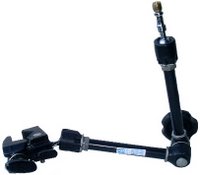(By Loren Worthington, Phoenix Arizona)I'm a photography enthusiast at best. That means I don't know near enough about photography but I tend to spend all my disposable money on anything to do with photography.
I'm also a C-5/6 quad. That means I use a wheelchair all day long and it means my fingers don't work too good. Not much about photography is designed with paralysis in mind so just getting the camera to point at what you see and to click the shutter can be a major ordeal.
My first camera was a 3 year old Olympus C-550. I bought it because the LCD swiveled. This allowed me to hold the camera on my lap and still see what the camera was pointing at. It also comes with wireless I/R remote control (infra-red). By placing in my mouth, I bounced the signal into the I/R port, and I was in business. The 5-meg camera takes great photos and is perfect for learning. While the I/R shutter control sorta works, its by no means ideal.
I soon began shopping for a D-SLR camera. In May 2006, Olympus introduced the E-330. The 8-meg camera was the first SLR to have a live LCD and even better, it pivots which allows me a little more creativity in selecting perspective. I spent many hours on-line and I still can find no perfect way to control the shutter of a camera given my abilities. Like most anything a quad accomplishes, I just bought the camera and figured I'd find a way.
Within a week I had two products attached to the camera and they were a great improvement. Skydivers take photos using a mouth control. The best one is made by
Conceptus in Arizona. The tongue switch is universal and can adapt to many cameras. This is really a great product.
Unfortunately, the E-330
doesn't have a port for a wired remote and so I found a chap in
th UK who makes a clever I/R adapter (
gentLed) and things looked promising. Before shipping the compact I/R converter, he modified it with a 2.5mm plug that connected to the tongue switch. She works good. I can hold the eye piece to my eye and click of photo after photo.

 There is
There is a few downsides to this set up;
- The wiring is fragile and requires attention to assure everything is just right
- It requires care when stowing
- It sure doesn't look too pretty
- The adaptation doesn't allow you to utilize the features you have available by pushing the shutter button half-way down for focusing.
- There is still an appx. 1/2 second lag between the time you hit the switch and the shutter closing
Its the last item that really can make photography frustrating. A 1/2 second delay when shooting landscapes is irrelevant. But add any people, dogs or kids, and a great photo becomes a chance thing.
I have been googling for 9 months and am yet to find a better solution for my E-330. Its a great camera for wheelchair use because you can use the LCD real time and this means you really can get some non-typical wheelchair perspective. If I could devise a way to get real-time shutter response, this would be a perfect camera. If anyone out there has enough finger-control to use the actual shutter button, I'd recommend the E-330. Add the 50-200mm lens and its really fun.



